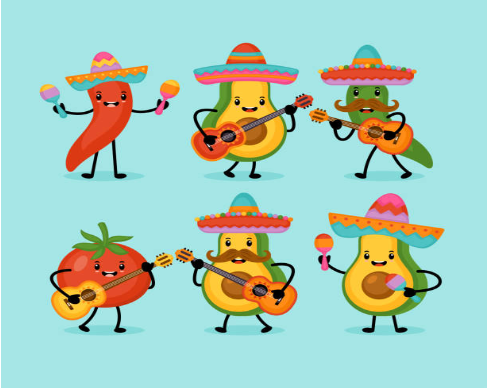Mexican Сartoon Сharacter: Top 10 Most Popular

Table of Contents
From the mischievous antics of El Chavo del Ocho to the empowering spirit of Pepita la Pistolera, Mexican cartoon characters have captivated audiences for generations. Their stories transcend mere entertainment, weaving threads of laughter, adventure, and social commentary into the fabric of Mexican culture. Whether you’re a nostalgic fan reminiscing about childhood favorites or a curious newcomer seeking to discover hidden gems, this journey into the vibrant world of Mexican animation promises an enriching experience.
Top 10 Most Popular Mexican Cartoon Characters
El Chavo del Ocho
An orphaned eight-year-old residing in a barrel, El Chavo’s mischievous antics and quest for his signature “torta de jamón” (ham sandwich) sparked laughter and resonated with viewers across generations. His portrayal of childhood struggles and friendships painted a relatable picture of life in a lower-middle-class neighborhood.
La Chilindrina
Daughter of Doña Florinda, La Chilindrina’s freckled face and mischievous grin became synonymous with playful taunts and witty remarks. Her character served as a foil to El Chavo, adding comedic chaos to their friendship dynamic.
Cantinflas
The animated version of Mexico’s legendary comedian, Mario Moreno “Cantinflas,” preserved his signature humor and social commentary. His nonsensical yet insightful monologues, delivered in his trademark rapid-fire speech, entertained audiences while subtly addressing societal issues.
Memín Pinguín
Memín, a penguin with an Afro hairstyle, stood out in a society unfamiliar with his background. He faced prejudice and navigated social issues, sparking conversations about tolerance and acceptance. His adventures highlighted the struggles of being different and advocated for understanding amidst cultural differences.
Pepita la Pistolera
As a cowgirl in the Wild West, Pepita shattered stereotypes of damsels in distress. Her bravery, sharpshooting skills, and unwavering determination in fighting for justice empowered young viewers, especially girls, to challenge expectations and embrace their inner strength.
Top Cat (Topolino)
Inspired by “Top Cat” from Hanna-Barbera, Top Cat, a cunning feline with a laid-back demeanor, orchestrated elaborate schemes with his alley cat gang. Their humorous escapades and witty dialogue, often referencing jazz music and pop culture, provided lighthearted entertainment for audiences of all ages.
El Chapulín Colorado
Despite his awkwardness and comical blunders, El Chapulín Colorado’s unwavering desire to help others endeared him to viewers. His signature phrases like “no contaban con mi astucia” (“you didn’t count on my cunning”) and unique gadgets provided slapstick humor while emphasizing the importance of good intentions and perseverance.
Don Gato y su Pandilla
This animated adaptation of “Cattanooga Cats” presented Don Gato, a mischievous yet charming cat, and his jazz-loving gang. Their musical escapades, often involving Officer Matute’s pursuit, combined slapstick humor, catchy tunes, and lighthearted adventures.
Aprende con Chispin
This educational show’s mascot, Chispin, a friendly and enthusiastic dog, guided children through fun and engaging learning activities. With Chispin’s help, young viewers explored various subjects and developed literacy skills in a way that was both informative and entertaining.
Maya & Miguel
This co-production between Mexico and Argentina showcased the cultural exchange between the two countries through the adventures of Maya and Miguel, two young friends. Their stories emphasized the importance of understanding different cultures, celebrating similarities, and building meaningful friendships despite geographical distance.
Beyond the Classics
The landscape of Mexican animation extends far beyond the aforementioned characters. Modern gems like “El Tigre: The Adventures of Manny Rivera” offer nuanced portrayals of Mexican-American identity, while shows like “¡Mucha Lucha!” inject Lucha Libre culture into superhero antics. These newer additions demonstrate the continuous evolution and growth of Mexican animation, reflecting contemporary themes and engaging new generations.
Global Impact
The influence of Mexican cartoon characters transcends national borders. Dora the Explorer, a co-production with the US, introduced millions of children worldwide to Spanish language and Latin American culture. Similarly, Maya & Miguel fostered intercultural understanding, highlighting the positive impact of these characters in bridging cultures and promoting global connection.
Challenges and Future Prospects
Despite its rich history and passionate fanbase, Mexican animation faces challenges like limited budgets and competition from international giants. However, initiatives like Anima Estudios and festivals like Pixelatl showcase the industry’s resilience and innovation. As online platforms like Netflix invest in local content, future prospects for Mexican animation appear bright, paving the way for even more diverse and compelling stories to reach global audiences.
Conclusion
Mexico’s vibrant tapestry of cartoon characters reflects the nation’s cultural richness, sense of humor, and commitment to social commentary. From classic icons like El Chavo del Ocho to modern gems like El Tigre, these characters entertain, educate, and inspire audiences worldwide. As the industry continues to evolve, the future holds exciting possibilities for even more diverse and impactful Mexican animation to captivate viewers for generations to come.
FAQ
Where can I watch these Mexican cartoons?
Streaming platforms like Netflix, YouTube, and Claro Video offer various Mexican cartoons. Additionally, some classic shows might be available on traditional television channels in Mexico or through DVD releases.
What other notable Mexican cartoon characters should I explore?
Countless characters deserve recognition! Consider diving into characters like Rita y Copetín, Remi, Chabelo, and Alebrijes, each with unique stories and contributions to Mexican animation.
How can I support Mexican animation?
Watching and recommending Mexican cartoons, attending animation festivals, and supporting studios and productions are great ways to contribute. Engaging with online communities and discussions about Mexican animation also fosters awareness and appreciation.
Support Ukraine against russian fascists! Defend Europe from horde! Glory to Ukraine! 🇺🇦

George Brown is a main editor in Bitgraph Network Team.